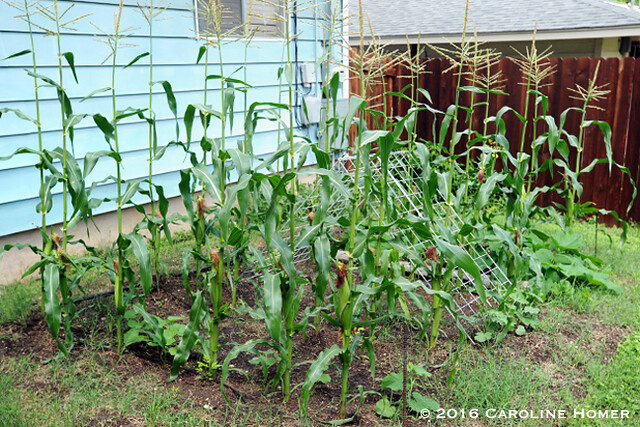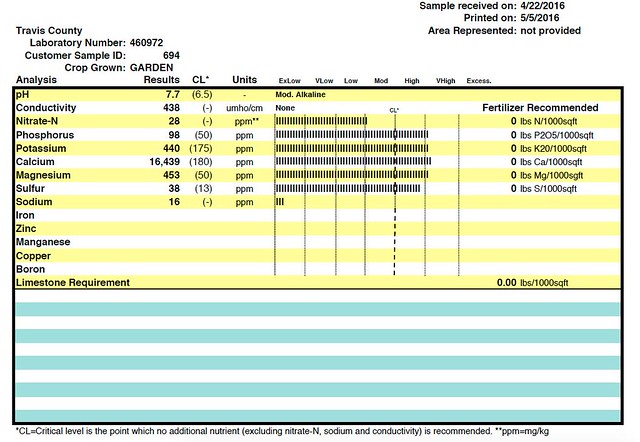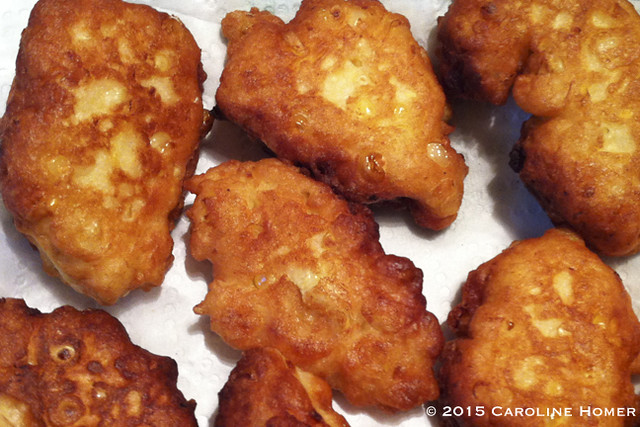A couple more weeks to fresh sweet corn
Looks like my corn patch may produce a few edible ears after all.

In Central Texas, early April is the best time to plant sweet corn; our summers get too hot too quickly for that "knee high by the Fourth of July" business. I had to break down half my raised beds before the new fence was installed, and the raised beds I had left were already full of tomatoes and bush beans, so I decided to till up a patch of weedy soil and plant right away rather than wait and try to build a raised bed. That's OK; I wanted a bigger corn patch this year anyway.

I'm not sure if this variety, 'Luscious', is a great one for this area, but I've had luck with it before. My seed source says it's best grown above the 40th parallel, and Austin is on the 30th. The plants of this particular variety tend to be shorter - six feet - and the corn cobs form in the bottom two feet of the plant.

I had the soil tested at the Soil Kitchen tent at the East Austin Garden Fair, and all the nutrients came back at moderate levels or above, except for sodium, which is not a desirable thing to have in a high quantity in soil. Because corn is a heavy feeder and the soil nitrogen level didn't test at excessively high levels, I did fertilize with cottonseed meal (high in nitrogen, low in everything else) when the plants were about a foot tall, back in April, and when the silks appeared last week.

The plants look a little more spindly than last year's crop, but we've had good rain - I've only had to irrigate the patch a couple of times in the past two months - and all the plants have ears. I've been "hoeing my rows" to keep the weeds down. It hasn't been as warm or sunny in the past month, due to all the rain, though we're getting a little sun today, on and off. This last couple of weeks is when the kernels put on all their "weight", so I'm hoping those ears keep getting bigger (and the critters stay away).

Even if the critters get a few, I'll be happy if we get enough corn to make fritters, yum!

I got a good fritter recipe out of The Victory Garden Cookbook. It's a good way to use those less-than-fully-filled ears, and the ears that the worms eat halfway down. There's a corn chowder recipe in there that's pretty good, too; I'll make it again if we get a really good harvest.

Maybe we'll even get a few fully-filled ears like we did last year. I'm not too picky, Mother Nature; just let us have some!

Words and photos © 2009-2016 Caroline Homer for "The Shovel-Ready Garden". Unauthorized reproduction is prohibited.

In Central Texas, early April is the best time to plant sweet corn; our summers get too hot too quickly for that "knee high by the Fourth of July" business. I had to break down half my raised beds before the new fence was installed, and the raised beds I had left were already full of tomatoes and bush beans, so I decided to till up a patch of weedy soil and plant right away rather than wait and try to build a raised bed. That's OK; I wanted a bigger corn patch this year anyway.

I'm not sure if this variety, 'Luscious', is a great one for this area, but I've had luck with it before. My seed source says it's best grown above the 40th parallel, and Austin is on the 30th. The plants of this particular variety tend to be shorter - six feet - and the corn cobs form in the bottom two feet of the plant.

I had the soil tested at the Soil Kitchen tent at the East Austin Garden Fair, and all the nutrients came back at moderate levels or above, except for sodium, which is not a desirable thing to have in a high quantity in soil. Because corn is a heavy feeder and the soil nitrogen level didn't test at excessively high levels, I did fertilize with cottonseed meal (high in nitrogen, low in everything else) when the plants were about a foot tall, back in April, and when the silks appeared last week.

The plants look a little more spindly than last year's crop, but we've had good rain - I've only had to irrigate the patch a couple of times in the past two months - and all the plants have ears. I've been "hoeing my rows" to keep the weeds down. It hasn't been as warm or sunny in the past month, due to all the rain, though we're getting a little sun today, on and off. This last couple of weeks is when the kernels put on all their "weight", so I'm hoping those ears keep getting bigger (and the critters stay away).

Even if the critters get a few, I'll be happy if we get enough corn to make fritters, yum!

I got a good fritter recipe out of The Victory Garden Cookbook. It's a good way to use those less-than-fully-filled ears, and the ears that the worms eat halfway down. There's a corn chowder recipe in there that's pretty good, too; I'll make it again if we get a really good harvest.

Maybe we'll even get a few fully-filled ears like we did last year. I'm not too picky, Mother Nature; just let us have some!

Words and photos © 2009-2016 Caroline Homer for "The Shovel-Ready Garden". Unauthorized reproduction is prohibited.
When my husband and I had a large allotment, we did try growing corn, but didn't have much success. Then, when we bought our first house with a small patch of ground, we gave up our allotment -- and have been regretting that for over 30 years. They're like gold in the city now. I admire your success, and really love corn. During corn season, we might have it twice a week from the farmer's market. Ours never gets past the cob stage, though. Corn fritters sound wonderful, and corn chowder, too. Maybe this year we'll give them a try.
ReplyDeleteGreat to see you at the Fling again. Till next year in DC! Happy gardening.